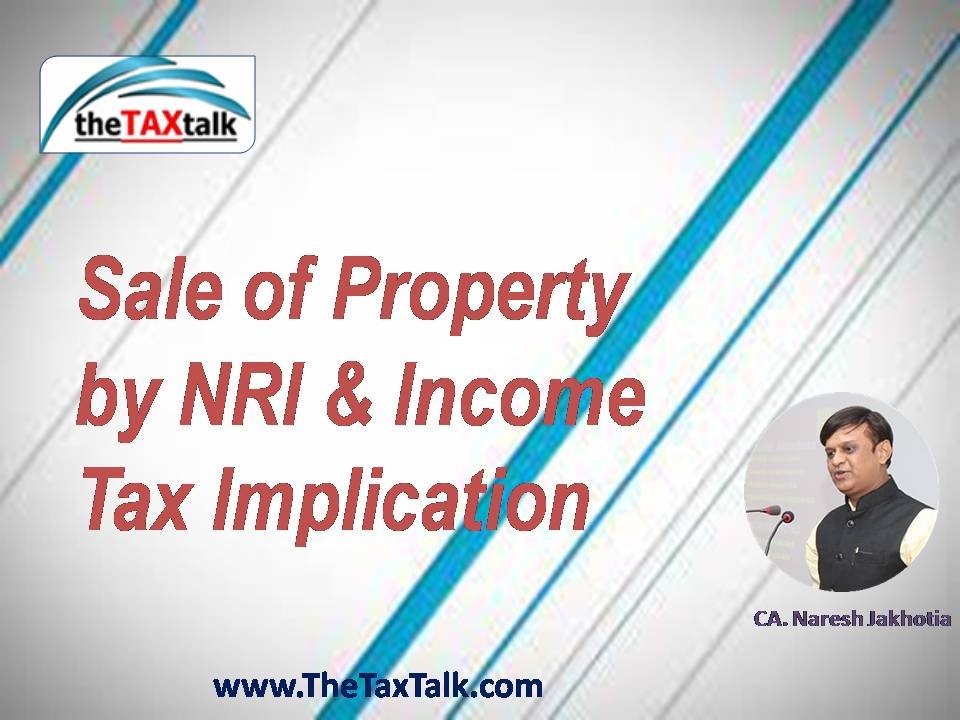![]()
Sale of Property by NRI & Income Tax Implication
Query 1]
I am an NRI & since last 2 years. I have settled in the U.S.A & do not have any Income in India for the financial year 2023-24 in India. I have sold the property in India. Whether any income tax liability would arise on sale of the property? If yes, kindly guide how much will be the Capital Gain Tax on my house property sold on 15/1/2024. The house property was situated at Koradi Road, in Nagpur City & was sold for Rs. 55,00,000/-. I purchased the Plot in the year 2013 (April) for Rs. 6,50,000/- and constructed an Independent House in the year 2013. Construction cost is near about Rs. 25,00,000/- & was completed in 2013 only. Whether the benefit of indexation is available to me? Is there any option to save tax like investment in NHAI Bonds, etc? Your legal opinion in this matter will be highly obliged.
Opinion:
- Even if you are an NRI, income on sale of the property in India is taxable in India.
- There is no distinction between an NRI and a non NRI as far as benefits of indexation on residential property is concerned. All the taxpayers are entitled to avail the benefit of indexation of a residential house property if the same is sold after 24 months. The amount would result in Long Term Capital Gains (LTCG).
- Computation of Capital Gain:
a) You have sold the property on 15/01/2024 (i.e., FY 2024-25). The Cost Inflation Index (CII) for FY 2023-25 is 348. Though you have sold the property for Rs. 55 Lakh, you need to check if the stamp duty valuation of the property is more than Rs. 55 Lakh or not. If the stamp duty valuation of the property is more than 110% of the actual sale consideration then the capital gain would be required to be computed by taking stamp duty valuation of the property.
b) You have purchased the property in April-2013 (FY 2013-14) for Rs. 6.50 Lakh. The CII for the FY 2013-14 is 220.
As a result, the indexed cost of acquisition would be Rs.10.44 Lakh (i.e., Rs. 6.60 Lakh *348/220). You can add the cost incurred towards stamp duty, registration expenses, etc to the purchase cost of Rs. 6.50 Lakh and can get additional deduction to this extent. - c) The construction/development was also done in the same FY 2013-24. The indexed cost of improvement would be Rs. 39.55 Lakh (i.e., Rs. 25 Lakh *348/220)
d) Your LTCG would be Rs. 5.01 Lakh (i.e., Rs. 55 Lakh -10.44 Lakh – 39.55 Lakh). It is taxable @20% plus education cess. - You have two options to save the tax on the LTCG from sale of a residential house property as under:
- a)Exemption U/s 54:
You can buy or construct another residential house within the prescribed time period. - b)Exemption U/s 54EC:
You can invest such capital gains in specified capital gains bonds issued by Power Finance Corporation( PFC), Rural Electrification Corporation Limited (REC), Indian Railway Finance Corporation (IRFC). The benefit of exemption U/s 54EC for National Highway Authority of India or NHAI bonds has been discontinued w.e.f. 09.09.2022.
Query 2]
You have earlier informed in The Tax Talk that there is a partial withdrawal facility as well as loan facility from PPF A/c. Can you please guide me about it. Whether amount withdrawn or loan availed from PPF A/c is taxable or tax free? I wish to withdraw the amount and invest it in the stock exchange.
Opinion:
- The amount received from PPF A/c after partial withdrawals or by way of loan is not at all taxable.
- Loan facility on PPF A/c:
Rule 10 of the PPF Scheme ensures loan facility to the taxpayers. Loan facility is available from the 3rd financial year. However, loan facility cannot be availed after the completion of 5 years from the end of the year in which the account was opened. (After completion of 5 years, partial withdrawal facility can be availed). Maximum amount of loan permissible cannot exceed 25% of amount as standing in the account at the end of the 2nd year immediately preceding the year in which the loan is to be applied for. For loan, application has to be done in Form D. - Partial Withdrawals from PPF A/c:
Loan facility is not available after completion of 5 years period. In such a case, Rule 9 of the PPF rules allows partial withdrawals from the account without losing any tax benefit. Withdrawal (in Form C) is permitted at any time after the expiry of 5 years from the end of the year in which the initial subscription was made. Maximum withdrawals permissible is up to 50% of the amount standing (a) at the end of the fourth year immediately preceding the year of withdrawal or (b) at the end of preceding year, whichever is lower. This 50% amount would further be reduced by the amount of loan, if any, availed & remained unpaid by the depositor. Note that only one withdrawal is permissible in any one year. In case the PPF account is extended for a further period of 5 years by the depositor after a completion of 15 years period, then the withdrawal is permissible up to 60% of the balance at his credit at the end of 15 years period.
[Views expressed are the personal view of the author. Readers are advised to seek professional advice before taking any decisions. Readers may forward their feedback & queries at nareshjakhotia@gmail.com. Other articles & response to queries are available at www.theTAXtalk.com]


